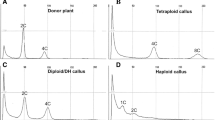Summary
To improve the efficiency of papaya anther culture, we investigated (1) hormonal medium conditions for inducing haploids or dihaploids; (2) identified the sex of established plantlets using a sex-specific DNA molecular marker and (3) estimated their ploidy by flow cytometry analysis of DNA content. Anthers with a mixture of uninucleate, mitotic, and binucleate microspores were collected from a male plant, and cultured on MS agar medium with different concentrations of CPPU and NAA. An embryo induction rate of 13.8% was attained on MS agar medium with 0.01 mg l−1 CPPU and 0.1 mg l−1 NAA. The induced embryos were subcultured on medium with 0.0025 mg l−1 CPPU. Rooting of the developed shoots was promoted by treating their basal parts with 1500 mg l−1 IBA in a 50% ethanol solution for about 10 seconds. All the embryo-derived plantlets (27 plants) were identified as female, implying that they were derived from microspores. In addition, 26 plants were determined to be triploids and one to be tetraploids. We also observed a wide range of morphological variation (e.g., in tree height and fruit size) among the established plants. Based on the results, we discussed a potential value of anther culture techniques for the breeding of papaya.
Similar content being viewed by others
Abbreviations
- CPPU:
-
N-(2-chloro-4-pyridyl)-N′-phenylurea
- NAA:
-
∂-naphthalene acetic acid
- SCAR:
-
sequence-characterized amplified region
References
Aquilizan, F.A., 1987. Breeding systems for fixing stable papaya inbred lines with breeding potential for hybrid variety production. In: Prodeedings of the International Symposium on The Breeding Horticultural Crops held at Chung Hsing University, Taiwan, December 1986. FFTC Book Series No. 35, Taipei, Taiwan, pp. 101–106.
Bajaj, Y.P.S., 1990. In vitro production of haploids and their use in cell genetics and plant breeding. Springer-Verlag, Berlin Heidelberg.
De Witte, K., S. Schroeven, W.Broothaerts & J. Keulemans, 1999. Anther culture in apple. In: K.R. Tobutt & F.H. Alston (Eds.), Proceedings of the Eucarpia symposium on fruit breeding and genetics, pp. 527–530. Acta Hortic 484, ISHS.
Dolcet-Sanjuan, R., E. Claveria & A. Huerta, 1997. Androgenesis in Capsicum annuum L.- Effects of carbohydrate and carbon dioxide enrichment. J Amer Soc Hortic Sci 122 (4): 468–475.
Drew, R.A. & N.G. Smith, 1986. Growth of apical and lateral buds of papaw (Carica papaya L.) as affected by nutritional and hormonal factors. J Hort Sci 61: 535–543.
Engvild, K.C., 1973. Triploid petunias from anther cultures. Hereditas 74: 144-147.
Engvild, K.C., I. Linde-Laursen & A. Lundqvist, 1972. Anther culture of Datura innoxia: Flower bud stage and embryoid level of ploidy. Hereditas 72: 331–332.
Gupta, P.P., 1982. Genesis of microspore-derived triploid petunias. Theor Appl Genet 61: 327–331.
Hofmyer, J.D.J., 1938. Genetical studies of Carica papaya L. South African J Sci 35: 300–304.
Hofmyer, J.D.J., 1967. Some genetic and breeding aspects of Carica papaya. Agron Trop 17: 345–351.
Kataoka, I. & H. Inoue, 1991. Rooting of tissue cultured papaya shoots under ex vitro conditions. Japan J Trop Agr 35 (2): 127–129.
Lai, C.C., T.A. Yu, S.D. Yeh & J.S. Yang, 1998. Enhancement of in vitro growth of papaya multishoots by aeration. Plant Cell, Tiss Organ Cult 53:221-225.
Litz, R.E. & R.A. Conover, 1978. Recent advances in papaya tissue culture. Proc Fla State Hortic Soc 91: 180–182.
Litz, R.E. & R.A. Conover, 1979. In vitro improvement of Carica papaya L. Proc Tropical Region, Am Soc Hort Sci 23: 157–159.
Magdalita, P.M., I.D. Godwin, R.A. Drew & S.W. Adkins, 1997. Effect of ethylene and culture environment on development of papaya nodal cultures. Plant Cell Tiss Organ Cult 49: 93–100.
Manshardt, R.M., 1992. Papaya. In: F.A. Hammerschlag & R.E. Litz (Eds), Biotechnology of Perennial Fruit Crops, pp. 489–511. CAB International, Oxon.
Murashige, T. & F. Skoog, 1962. A revised medium for rapid growth and bio assays with tobacco tissue cultures. Physiol Plant 15: 473–497.
Narayanaswamy, S. & L.P. Chandy, 1971. In vitro induction of haploid, diploid and triploid androgenic embryoids and plantlets in Datura metel L. Ann Bot 35: 535–542.
Ochatt, S.J. & Y.X. Zhang, 1996. In vitro haploidization of fruit trees. In: S.M. Jain S.K. Sopory & R.E. Veilleux (Eds). In vitro Haploid Production in Higher Plants. vol. 2, pp. 193–210. Kluwer Academic Publishers, Dordrecht.
Palmer, C.E. & W.A. Keller, 1997. Pollen embryos. In: K.R. Shivanna, & V.K. Sawhney (Eds), Pollen biotechnology for crop production and improvement, pp. 392–422. Cambridge University Press, New York.
Rimberia, F.K., H. Sunagawa, N. Urasaki, Y. Ishimine & S. Adaniya, 2005. Embryo induction via anther culture in papaya and sex analysis of the derived plantlets. Sci Hortic 103: 199–208.
Sopory, S.K. & M. Munshi, 1996. Anther culture. In: S.M. Jain, S.K. Sopory & R.E. Veilleux (Eds), In vitro Haploid Production in Higher Plants 1, pp. 145–176. Kluwer Academic Publishers, Dordrecht.
Storey, W.B., 1938. Segregations of sex types in solo papaya and their application to the selection of seed. Proc Amer Soc Hortic Sci 35: 83–85.
Storey, W.B., 1953. Genetics of the papaya. J Hered 44: 70–78.
Sunderland, N., G.B. Collins & J.M. Dunwell, 1974. The role of nuclear fusion in pollen embryogenesis of Datura innoxia Mill. Planta 117: 227–241.
Tsay, H.S. & C.Y. Su, 1985. Anther culture of papaya (Carica papaya L.). Plant Cell Rep 4: 28–30.
Urasaki, N., K. Tarora, T. Uehara, I. Chinen, R. Terauchi, & M. Tokumoto, 2002. Rapid and highly reliable sex diagnostic PCR assay for papaya (Carica papaya L.). Breeding Science 52: 333–335.
Zhang, Y.X. & Y. Lespinasse, 1992. Haploidy. In: F.A. Hammerschlag & R.E. Litz (Eds), Biotechnology of perennial fruit crops, pp. 57–75. CAB International, Oxon.
Author information
Authors and Affiliations
Corresponding author
Rights and permissions
About this article
Cite this article
Rimberia, F.K., Adaniya, S., Etoh, T. et al. Sex and ploidy of anther culture derived papaya (Carica papaya L.) plants. Euphytica 149, 53–59 (2006). https://doi.org/10.1007/s10681-005-9051-x
Received:
Accepted:
Published:
Issue Date:
DOI: https://doi.org/10.1007/s10681-005-9051-x




